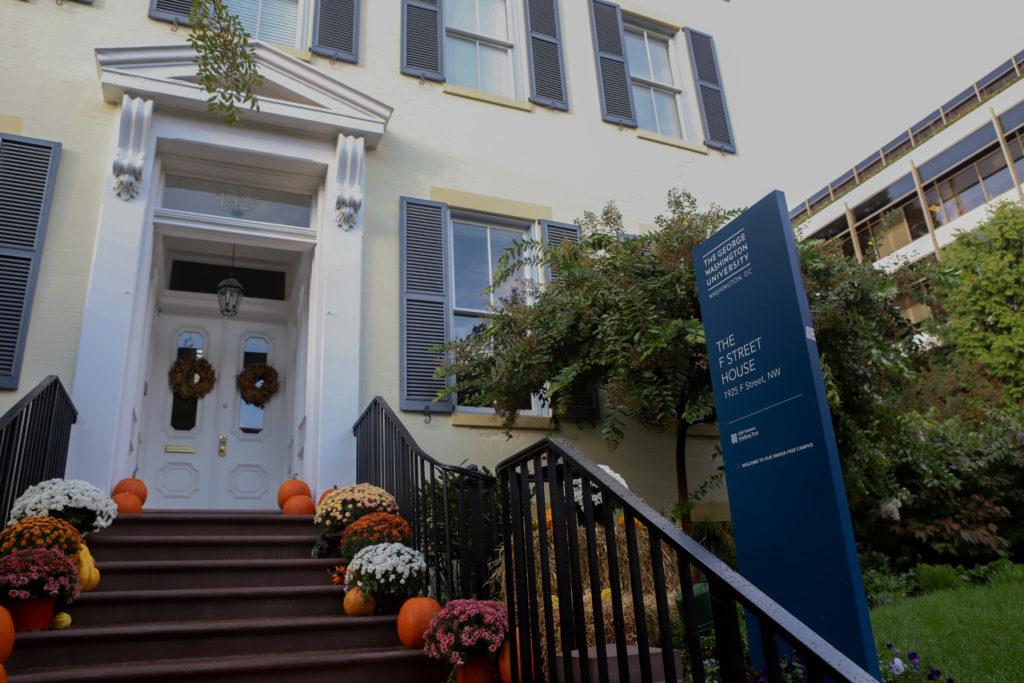Officials debuted a fundraising campaign directed at faculty and staff last month.
The campaign, branded “One GW,” kicked off with a reception at the F Street House, University President Thomas LeBlanc’s residence, last month and aims to encourage all GW employees to support GW financially, according to the campaign website. Philanthropy experts said successful campaigns allow employees to donate to departments based on their interests and press passionate employees to become ambassadors for the campaign.
“Every August, thousands of students return to GW, reminding us why we should support our University,” the website states. “As faculty and staff, we have the opportunity to see firsthand how philanthropy impacts students.”
University President Thomas LeBlanc said he hosted last month’s reception at his house to emphasize how critically he views the campaign. Previous faculty and staff donation campaigns at GW have resulted in millions of dollars in donations and secured about 20 percent participation from faculty and staff.
“It really was a thank you event to faculty and staff who give back and to encourage them to tell others about why they give back – and maybe encourage others,” he said.
Faculty and staff can donate through an online portal or set up a payroll deduction to automatically donate a fraction of their salary to the University, according to the campaign website.
LeBlanc said some faculty and staff may question why they should give back since they already work at GW, but he added that making a donation “strongly” supports aspects of the University’s mission beyond the individual’s work.
“It’s a part of institutions like ours that we think we have a higher calling, and we invite them to join us in that higher cause and support what they’re passionate about,” he said.
LeBlanc said he and his wife personally donate to GW each year.
“We think it’s important to help fund scholarships for students, because we went to school on scholarship, so our giving to the University funds student scholarships,” he said.
LeBlanc formalized philanthropy and constituent engagement as one of his five top priorities as president when he arrived on campus two years ago. The push to grow GW’s donor base comes as officials prepare to launch the next major capital campaign in 2021 in conjunction with GW’s bicentennial anniversary.
Provost Forrest Maltzman said he wants to “encourage” faculty to donate to the University through the campaign because philanthropic efforts are a vital form of support for GW’s programs.
Maltzman, who will step down from his role as provost in November and take a sabbatical before returning to GW as a professor, said he has donated to GW for “many” years and will continue to do so.
“I think it’s important for people to put a little bit of money where their mouth is, and the mission is critical,” he said.
Maltzman said his “dream scenario” is for 100 percent of faculty and staff to give any amount back to the University, and he is hopeful the new campaign will entice more faculty to donate.
“That’s a big dream,” he said. “But I think we can get closer, and I think it is really important.”
Maltzman added that faculty should donate to specific areas or funds at the University to support facets of GW they are interested in. Donors can apply their donation to specific departments or philanthropic funds – like the Athletics Buff and Blue Fund and the Power and Promise student aid fund – or specify their own priority, the website states.
“People should give to where they’re passionate,” he said. “The neat thing about faculty is when I talk to faculty to donate, they know the institution so well. I think it is a sign of our belief in the institution that they will give to the institution.”
Higher education fundraising experts said faculty and staff campaigns attract more donations when prospective donors can choose where their donation heads.
Jennifer Wheelock, the associate director of development marketing at the University of California Los Angeles, said successful campaigns can take “months” of planning by top officials, including the fundraising office and deans.
Wheelock said allowing employees to donate in programs that align with their individual interests can encourage them to donate, which improves the results of a fundraising campaign.
“Generally, they motivate faculty and staff and increase pride in their institution,” she said in an email.
Jennifer Keyes, the assistant vice president of individual philanthropic strategy at the Ohio State University, said schools can maximize donations by building up a base of passionate faculty and staff who can encourage other faculty and staff to donate.
“We know people are more likely to respond to an ask from someone they know versus an ask from the institution,” she said. “So a strong volunteer base advocating on behalf of your institution is important.”
Gina Speese, the associate director of annual giving and data analytics at Rockhurst University’s Office of University Advancement in Kansas City, Mo., said her institution increased philanthropic participation from faculty and staff by creating a fundraising committee, composed of representatives from different departments of the university, that engages in outreach to potential donors.
“That committee is really the arms and legs of fundraising,” Speese said. “So it’s not me making the ask to a colleague, it’s a coworker making the ask in different ways. That keeps the campaign very successful.”
Jared Gans and Parth Kotak contributed reporting.





